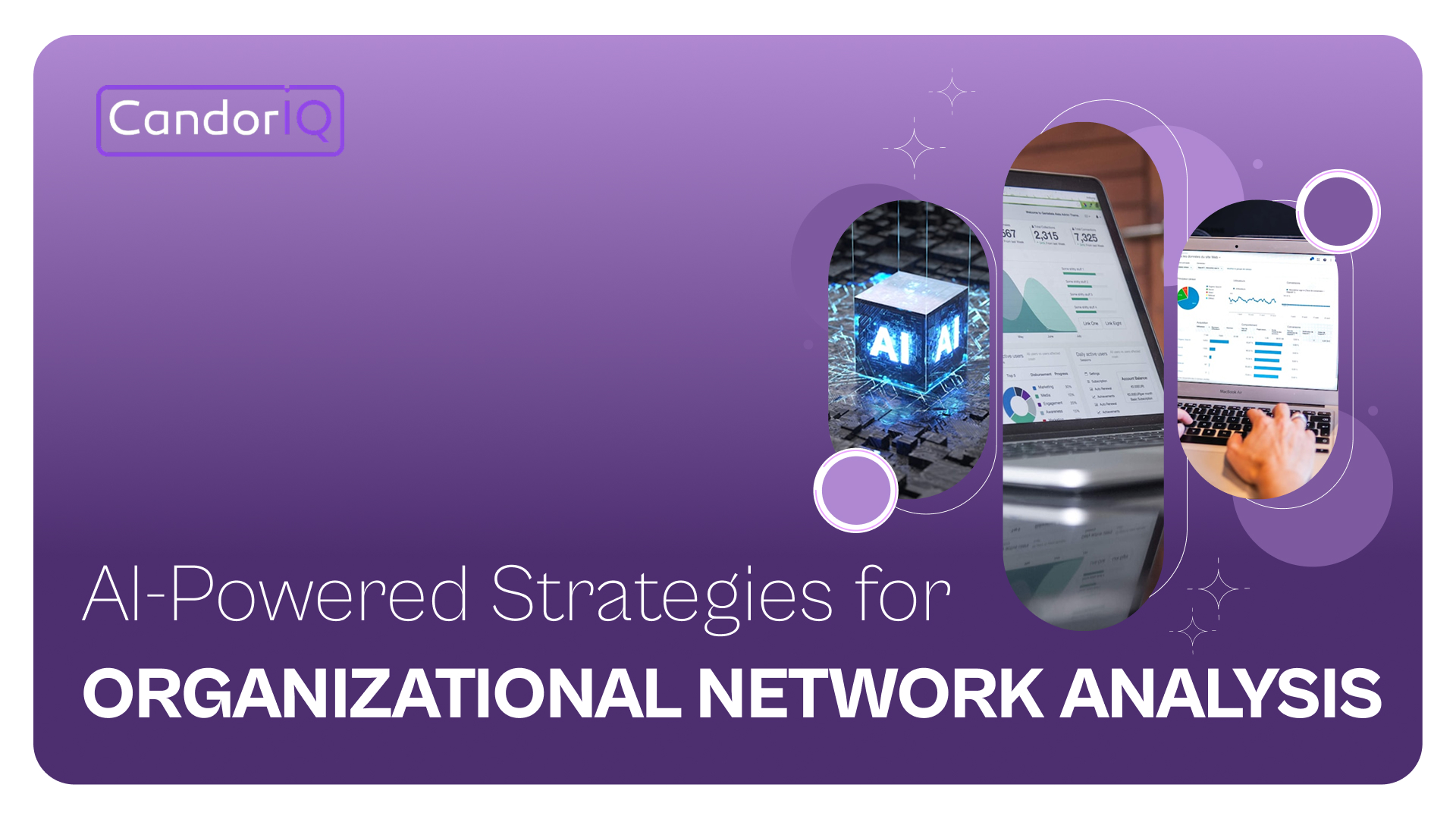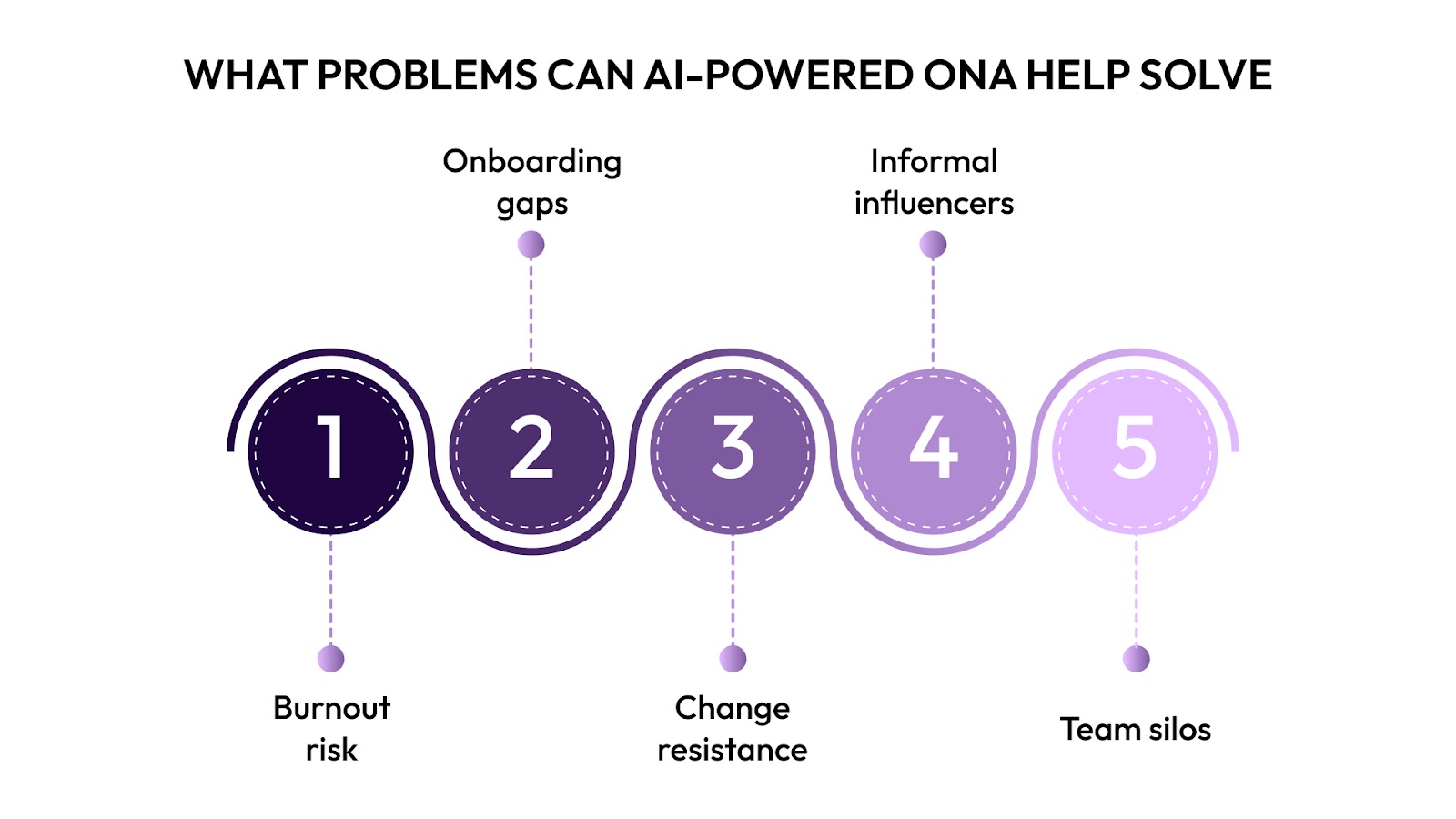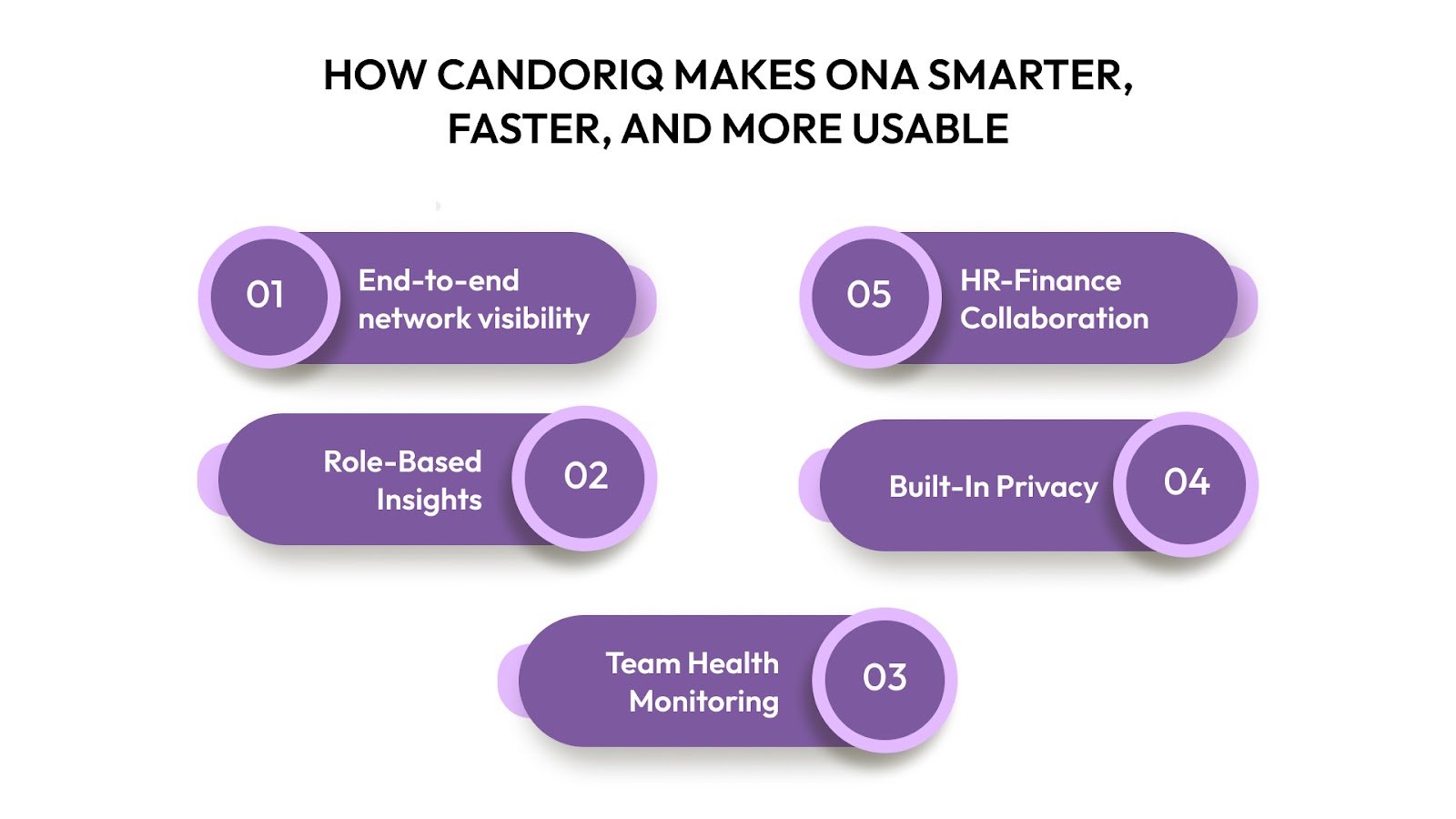AI-Powered Strategies for Organizational Network Analysis
Boost decision-making and collaboration with AI for organizational network analysis. Implement AI tools to unlock future trends. Explore AI solutions now!

In hybrid and remote environments, the real flow of work often disappears behind screens. Who influences decisions? Which teams collaborate cross-functionally? Leaders are left guessing, and traditional tools don’t offer much clarity.
That’s where Organizational Network Analysis (ONA) steps in and AI makes it even more powerful. By analyzing metadata from communication tools, calendars, and meetings, AI-enhanced ONA gives HR and operations leaders the ability to see how people actually connect and collaborate in real time.
For HRBPs, People Analytics leads, CHROs, and Ops teams in fast-scaling SaaS, fintech, and professional services companies, AI-powered ONA offers a better way to navigate change, manage talent, and build alignment as teams grow.
TL;DR
- Organizational Network Analysis (ONA) maps how work actually gets done by analyzing interactions, not just titles or hierarchies
- AI enhances ONA by automating data collection and delivering real-time insights into collaboration, burnout risk, silos, and influence
- Traditional tools fall short in hybrid and remote setups where informal connections drive performance but remain invisible
- HR and people leaders use AI-powered ONA to improve onboarding, identify hidden talent, track engagement, and support DEI goals
- The result is faster, evidence-based decision-making across workforce planning, retention, leadership development, and culture-building
What Is Organizational Network Analysis (ONA)?
Organizational Network Analysis is a way to understand how collaboration actually unfolds inside a company. Instead of focusing on formal hierarchies or job titles, ONA maps the relationships that drive information flow, decision making, and influence.
It helps identify:
- Individuals who act as central connectors within and across teams
- Bottlenecks that slow down execution or communication
- Isolated employees or departments at risk of disengagement
- Patterns of interaction that affect innovation, speed, and team effectiveness
By analyzing anonymized interaction data like meeting frequency, communication touchpoints, and cross-functional connections, ONA gives leaders a more accurate picture of how work gets done. This is especially critical in distributed or fast-changing environments, where informal dynamics often shape outcomes more than structure does.
Why Traditional Visibility Tools Fall Short

Most organizations rely on surface-level metrics like meeting hours, email volume, or project deadlines to assess collaboration. But these indicators rarely reveal the real dynamics of team effectiveness, trust, or influence.
Here’s where the gaps typically show up:
- Engagement blind spots: High meeting attendance does not equal real participation or inclusion.
- Invisible expertise: Informal mentors and problem-solvers often go unnoticed by performance reviews or org charts.
- One-size-fits-all interventions: Without understanding how each team works, blanket policies around return-to-office, wellbeing, or burnout risk miss the mark.
- Delayed reaction: By the time attrition signals appear in exit interviews or pulse surveys, it's often too late to intervene.
For fast-growing companies with distributed teams, these limitations add up quickly. Leaders need better context, not just more data. That’s where AI-powered ONA starts to shift the game.
How AI Makes ONA Actionable at Scale
AI doesn’t just speed up Organizational Network Analysis; it makes it usable across fast-changing, distributed environments where manual analysis falls apart.
Here’s what changes with AI in the mix:
- Automatic data ingestion: AI pulls communication metadata (like Slack messages, calendar invites, Zoom calls) to map connections, no need for manual surveys or interviews.
- Real-time pattern detection: Instead of reviewing static charts quarterly, AI highlights shifts in collaboration, team silos, or overburdened individuals as they emerge.
- Role-aware insights: AI understands organizational context, flagging when cross-functional teams are isolated, when new hires are not integrating, or when informal influencers are overloaded.
- Custom alerts and nudges: Managers can receive timely suggestions to rebalance workloads, initiate check-ins, or restructure meetings before issues snowball.
For HRBPs and People Analytics leads, AI transforms ONA from a research-heavy exercise into a living, operational signal that supports everyday decisions.
What Problems Can AI-Powered ONA Help Solve

AI-powered ONA helps uncover invisible patterns that static org charts and performance reviews often miss. It surfaces risks and inefficiencies that directly impact team performance, retention, and cross-functional alignment.
Here’s what it can solve in real time:
- Burnout risk: Identifies over-relied individuals based on high interaction volume across teams. Let HR intervene before top talent disengages.
- Onboarding gaps: Flags when new hires or remote employees are not forming connections within or across teams.
- Change resistance: Reveals teams or roles disconnected from key information flows during reorganizations or strategy shifts.
- Informal influencers: Spotlights high-impact employees who are central to collaboration but may not hold formal leadership roles.
- Team silos: Detects when departments stop interacting and isolates root causes behind failed cross-functional initiatives.
These insights help HR and People Ops teams take action early, based on real behaviors rather than assumptions.
Why HRBPs and People Leaders Need ONA Now
In fast-scaling organizations, speed often outpaces structure. Traditional HR data like engagement surveys or attrition reports only show part of the picture and often come too late. AI-powered ONA helps HRBPs, People Analytics leads, and CHROs close this gap with live, network-level insights.
Here’s why it matters now more than ever:
- Remote work has changed how teams connect: In hybrid and distributed setups, informal collaboration often goes unseen. ONA helps visualize who is working with whom, across time zones and departments.
- Scaling teams need better visibility: As companies grow from 100 to 1000 employees, new leaders emerge and old hierarchies shift. ONA surfaces patterns to ensure key knowledge holders are not left isolated.
- Retention depends on more than compensation: Identifying overburdened nodes or disconnected individuals early can reduce attrition. ONA reveals this long before exit interviews happen.
- Leaders want faster answers: Instead of waiting for quarterly reports, HR and operations teams can use ONA to monitor network health in real time and course-correct proactively.
With real-time visibility into relationships, influence, and collaboration, HR leaders can finally act with the clarity they need in high-growth environments.
How Teams Are Using AI-Powered ONA Right Now

AI-driven ONA is no longer a future concept. Forward-looking HR and people analytics teams are already putting it to work across different business scenarios. These use cases show just how practical and versatile the approach can be.
- Uncovering hidden talent: ONA helps identify employees who act as informal connectors or influence across teams but may not show up in traditional performance reviews. These rising stars often contribute significantly to knowledge-sharing and team cohesion.
- Improving onboarding for remote teams: AI can reveal how well new hires are integrating into the organization by tracking how quickly their network expands across functions. If someone remains isolated, it signals a need for additional support or introductions.
- Reshaping collaboration during reorganizations: When teams are restructured or new functions are added, ONA highlights which connections need to be preserved and where new ones should be built. This helps maintain workflow continuity and reduce friction during transitions.
- Strengthening manager effectiveness: ONA can evaluate whether managers are becoming bottlenecks or whether they are empowering their teams through distributed connections. It also helps pinpoint where support or coaching might be needed.
- Planning office returns with data: Companies piloting hybrid work can use ONA to understand who really benefits from in-person collaboration and which teams are thriving remotely. This enables smarter space usage and employee satisfaction.
These real-world examples show how ONA powered by AI is helping teams move from assumptions to evidence-based action.
CTA: Want to see what practical use cases would look like in your own environment? Let CandorIQ walk you through a tailored demo. Book now.
Practical Applications of AI-Driven ONA
AI-driven Organizational Network Analysis does more than visualize team interactions. It enables HR and operations leaders to diagnose and act on organizational dynamics in real time. Beyond identifying influencers or monitoring onboarding, here are other ways companies are putting AI-powered ONA to work:
- Spotting burnout early: AI algorithms can detect communication overload patterns such as excessive cross-functional meetings, after-hours messaging, or low reciprocity in interactions. These are early signs of disengagement or burnout that often go unnoticed in standard metrics.
- Optimizing team composition: ONA reveals whether a team is over-reliant on a few central connectors or if collaboration is evenly distributed. This helps redesign teams to prevent bottlenecks and ensure knowledge flow is balanced across contributors.
- Strengthening cross-team alignment: Instead of relying on org charts, ONA highlights how frequently different departments actually collaborate. If critical teams like Sales and Product show minimal connection, leaders can intervene to encourage strategic alignment.
- Tracking the ROI of leadership development: Post-training, ONA helps assess whether high-potential leaders are growing their internal networks. A broader, more diverse set of connections can indicate increased influence and initiative across the organization.
- Supporting DEI initiatives with network visibility: AI-enhanced ONA can surface whether employees from underrepresented groups are equally embedded in influential networks. This reveals whether inclusion is happening in practice, not just in policy.
By moving from static snapshots to ongoing network intelligence, AI-powered ONA allows fast-growing companies to stay ahead of culture, performance, and retention challenges.

What to Look for in ONA Platforms
Not all ONA tools are created equal. As the use cases for AI-powered network analysis expand, so do the number of platforms claiming to offer visibility into workplace dynamics. But for HR and people analytics leaders in fast-scaling companies, a good ONA solution must go beyond static charts and manual exports.
Here’s what truly sets enterprise-ready ONA platforms apart:
- Real time insights, not delayed reports: Look for platforms that surface dynamic network activity without relying on quarterly surveys or outdated metadata. Live dashboards should reflect how your organization is evolving every week, not every season.
- Seamless integration with everyday tools: The best tools plug directly into communication and collaboration systems you already use; Slack, Teams, Zoom, calendars, project tools and automatically generate insights from interaction patterns, not self reported data.
- Context aware analytics: An effective platform should distinguish between signal and noise. It should account for role seniority, team structure, geography, and hybrid setups to avoid misinterpreting high volume activity as high value.
- Actionable recommendations for leaders: Visibility is only useful when paired with guidance. Look for platforms that offer nudges, alerts, and decision support like highlighting isolated new hires, overloaded managers, or misaligned cross functional collaboration.
- Privacy safeguards and governance controls: Network data is sensitive. Ensure the platform provides robust anonymization, access controls, and clear guidelines on what is analyzed and shared. Ethical ONA tools put transparency and employee trust first.
- Customizability for different teams and workflows: Your engineering team collaborates differently than sales. The ideal ONA solution should allow you to tailor views and thresholds based on team dynamics, department goals, and leadership priorities.
Choosing the right ONA platform is not about more data. It is about the right signals, in the right context, at the right time.
How CandorIQ Makes ONA Smarter, Faster, and More Usable

CandorIQ is not just another ONA tool. It is built for fast-growing companies that need real-time clarity on how work actually happens across hybrid and distributed teams. By combining powerful AI with deep organizational context, CandorIQ turns raw interaction data into insights that are immediately useful for HRBPs, CHROs, and people analytics leaders.
Here’s how it supports smarter people decisions at scale:
- End-to-end network visibility: CandorIQ maps collaboration patterns across systems like Slack, Teams, Zoom, and calendars, giving you a unified view of how information flows, who is connected, and where silos may be forming.
- Role-aware insights with actionable next steps: Whether it is identifying a new hire who is isolated or a manager who is becoming a bottleneck, CandorIQ offers specific, context-driven insights. It does not just flag issues, it recommends what to do next.
- Live health monitoring for teams and departments: HR leaders can monitor network health metrics in real time. This includes cross-functional collaboration, workload concentration, or onboarding integration so you can intervene before risks turn into attrition.
- Data privacy built into the platform: CandorIQ prioritizes transparency and ethical analysis. It anonymizes sensitive interaction data, applies strict governance rules, and provides visibility only to authorized users.
- Designed for how HR and Finance work together: The platform supports collaborative compensation planning and organizational design, helping HR and Finance teams align workforce investments with actual behavior and influence, not just headcount.
CandorIQ makes it possible to operationalize ONA without the complexity. If you are looking to move beyond gut decisions and static org charts, this is the system that meets fast-moving HR teams where they are.
Curious how CandorIQ could map your organization’s hidden networks? Book a demo today and see how it fits into your people strategy.
See What You’ve Been Missing in Your Org Charts
Fast-growing companies can no longer afford to rely on static hierarchies and lagging indicators. With hybrid work, rapid scaling, and shifting team dynamics, understanding how collaboration and influence actually work inside your company has become a strategic advantage.
AI-powered Organizational Network Analysis offers that visibility. It helps HRBPs, CHROs, and people analytics leaders make decisions based on real interactions, not assumptions. From improving onboarding and reducing burnout to building stronger cross-team alignment, ONA surfaces the signals that traditional tools miss.
If your org chart hasn’t changed but your teams are feeling stuck, it's time to see what you’re missing. Let CandorIQ show you the hidden levers inside your workforce.

Frequently Asked Questions
Q: Is this type of network analysis invasive for employees?
Ans: No. AI-powered ONA uses aggregated and metadata-level communication patterns, not the content of messages. It focuses on how people connect, not what they say. This ensures privacy is respected while providing insights into collaboration health.
Q: Do we need employee consent for this analysis?
Ans: Most platforms operate within existing IT and compliance policies using metadata from approved tools. Still, transparency is key. Communicating the purpose and benefits of ONA helps build trust and ensure alignment with privacy regulations.
Q: How often is the data updated?
Ans: Unlike traditional surveys or quarterly reports, AI-driven ONA updates in near real-time. This makes it easier to spot shifts in engagement, collaboration, or burnout risks before they escalate.
Q: Will this replace engagement surveys or performance reviews?
Ans: No. ONA complements existing tools by adding a behavioral layer that shows how work actually happens. It helps explain the “why” behind survey scores or performance outcomes.
Q: Is this just for large enterprises?
Ans: Not at all. ONA can be especially valuable for mid-sized companies that are growing fast and navigating hybrid or distributed work. It helps HR and Ops leaders stay ahead of culture and people's challenges before they scale.


